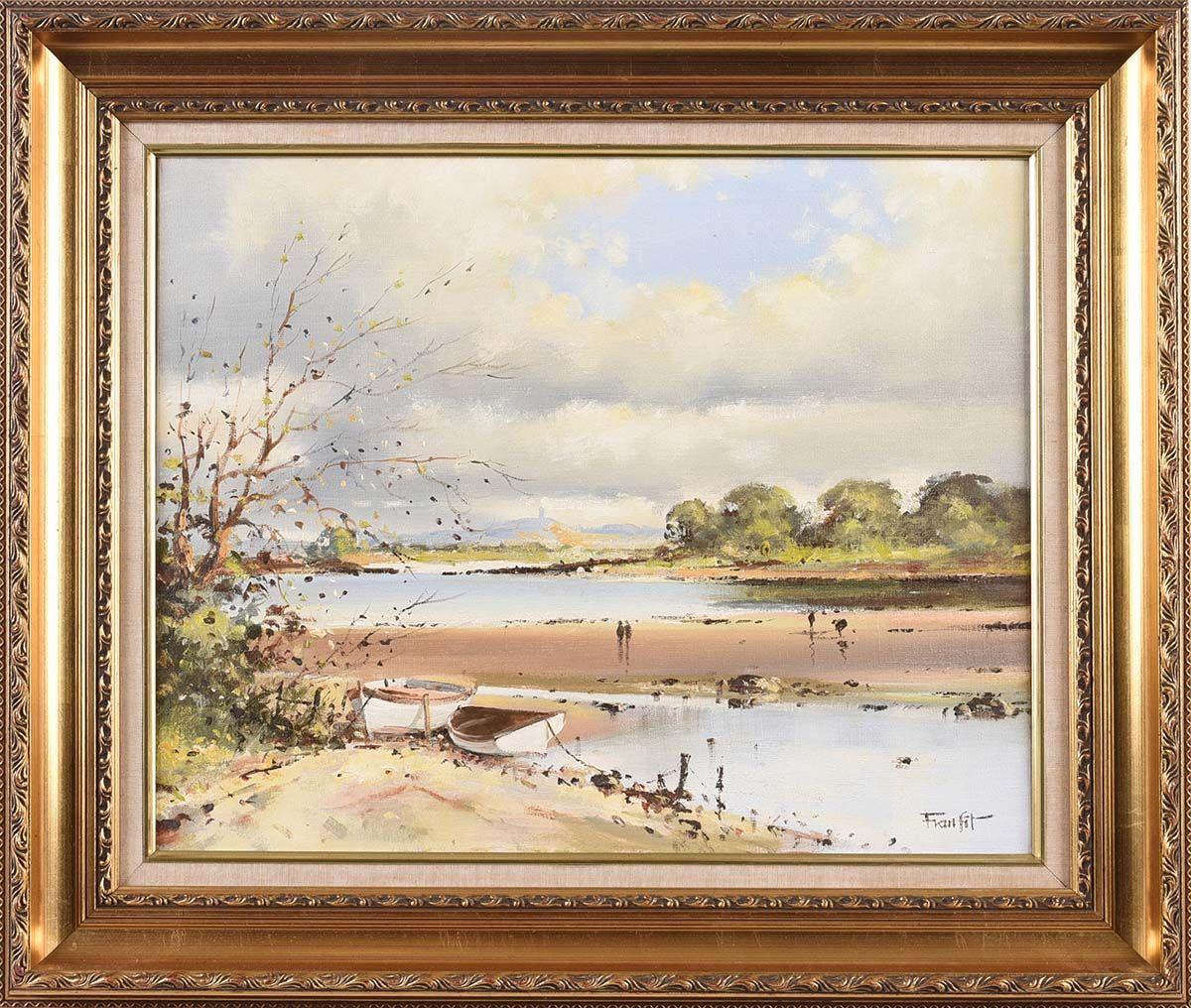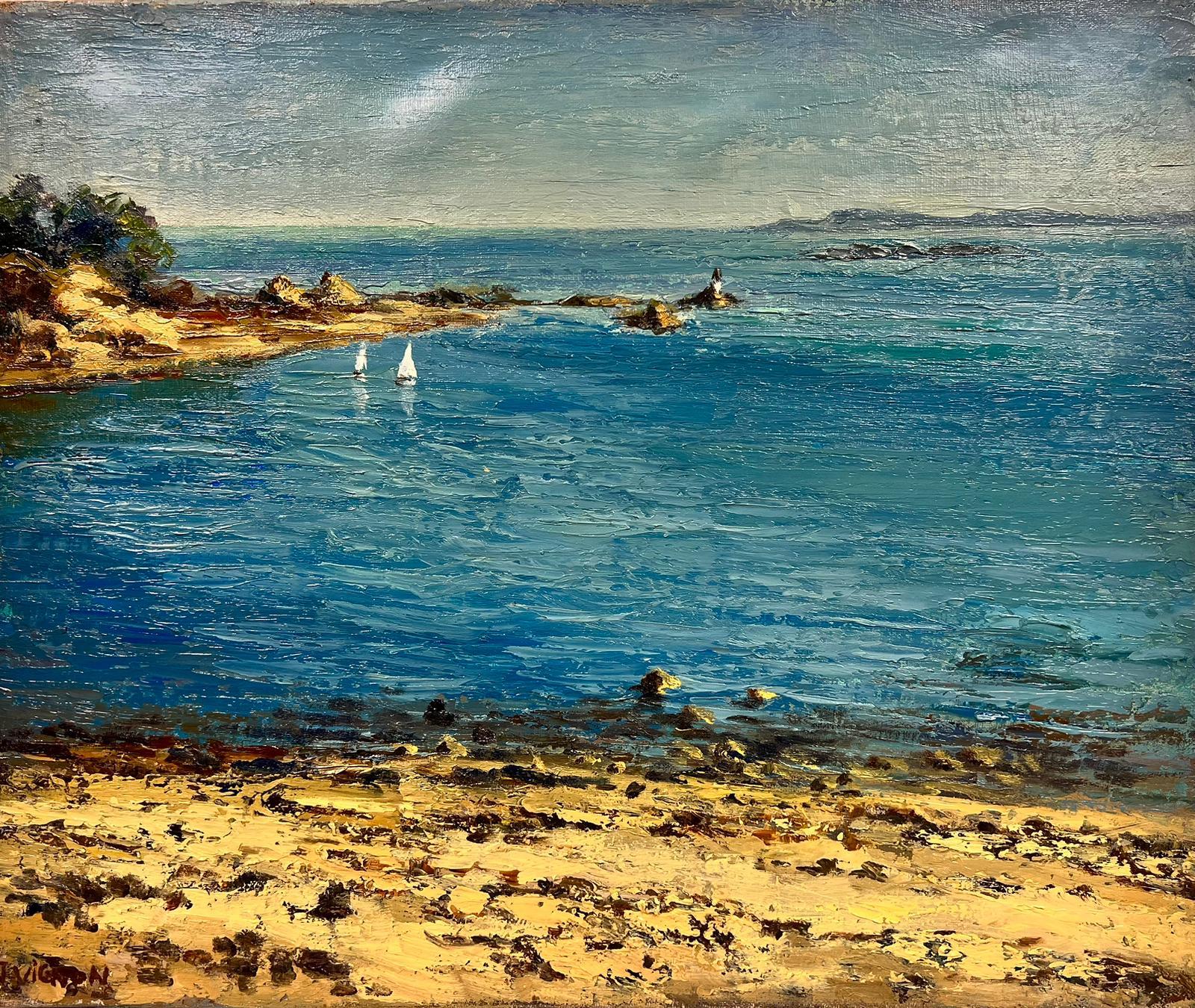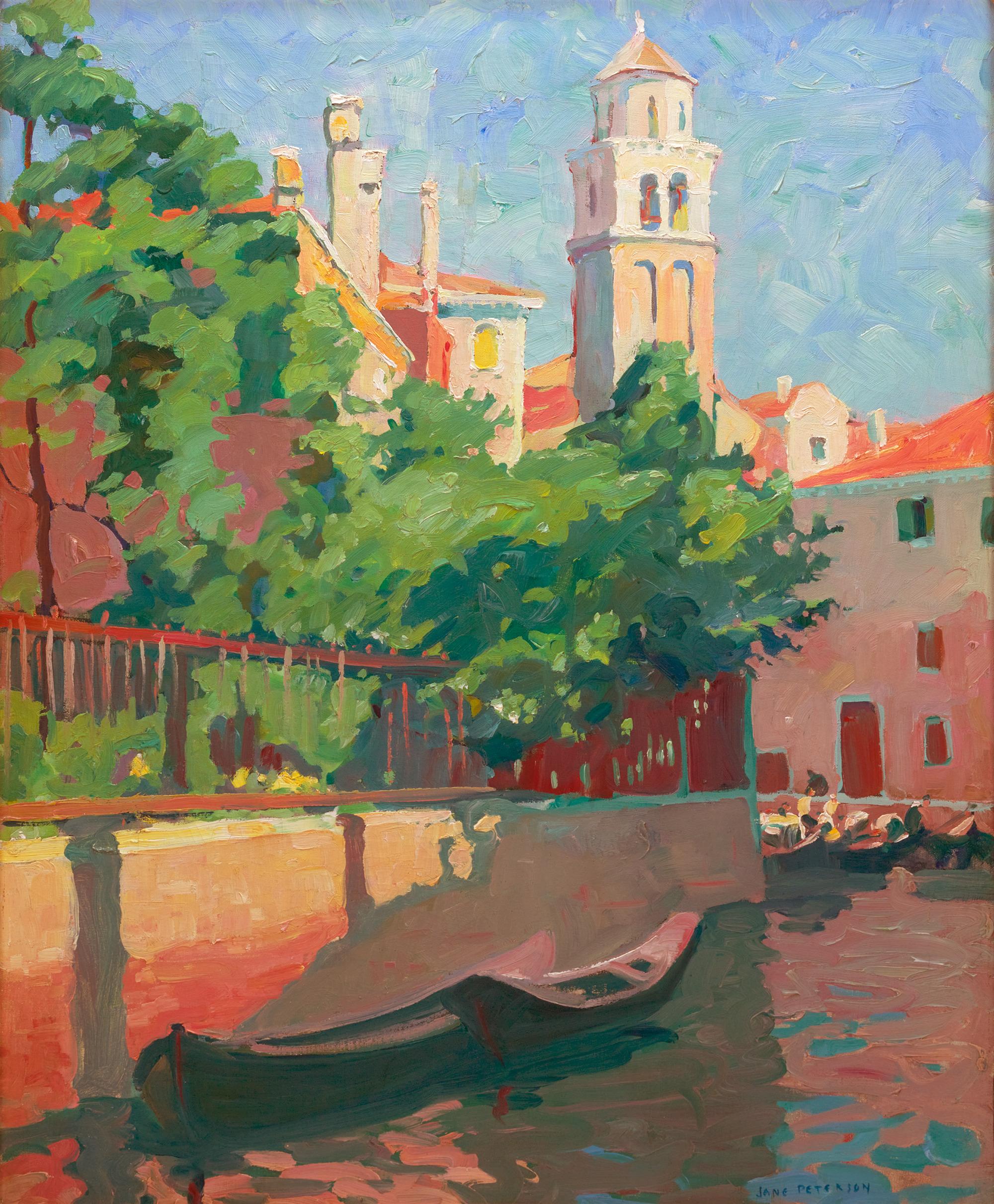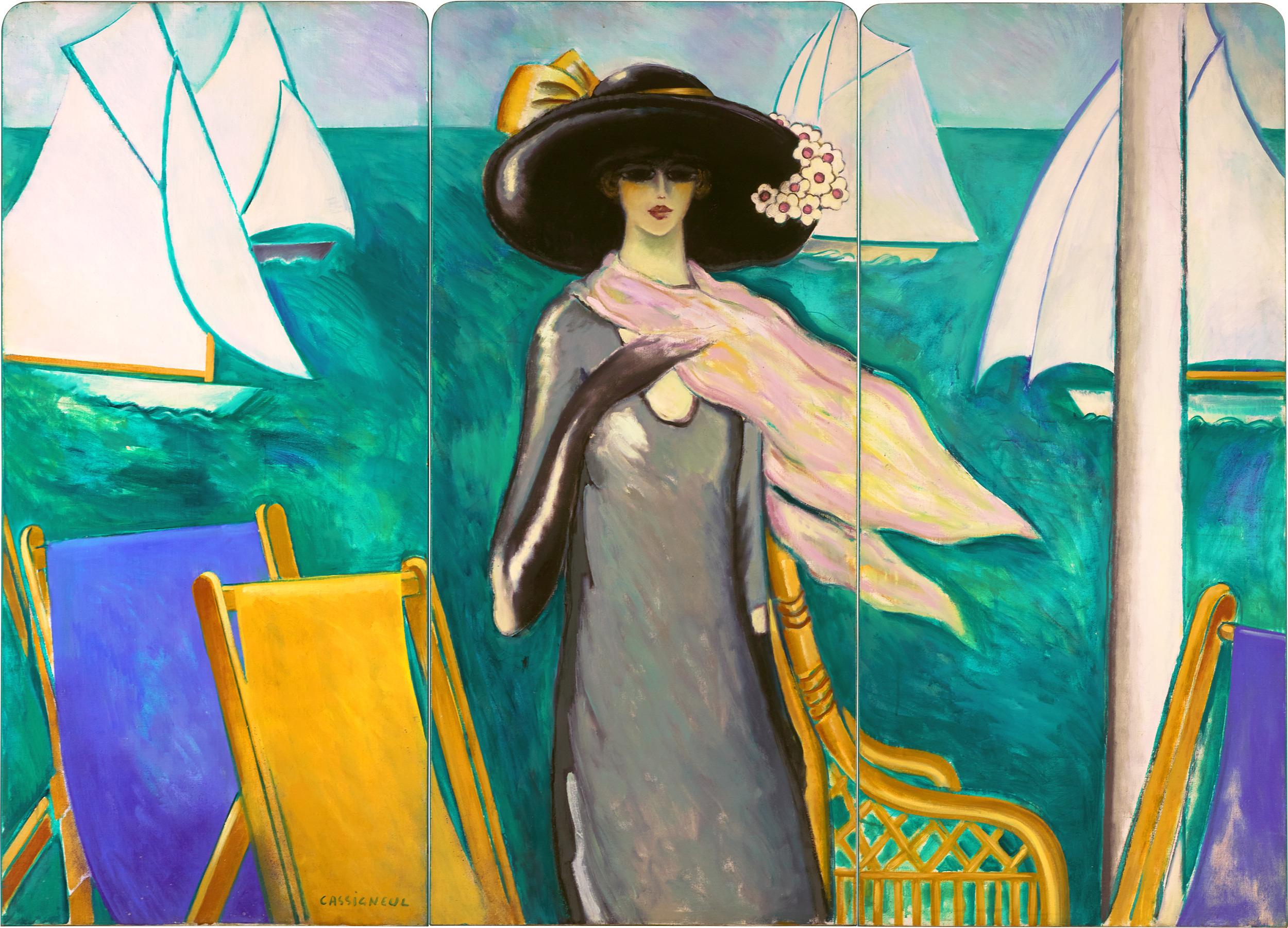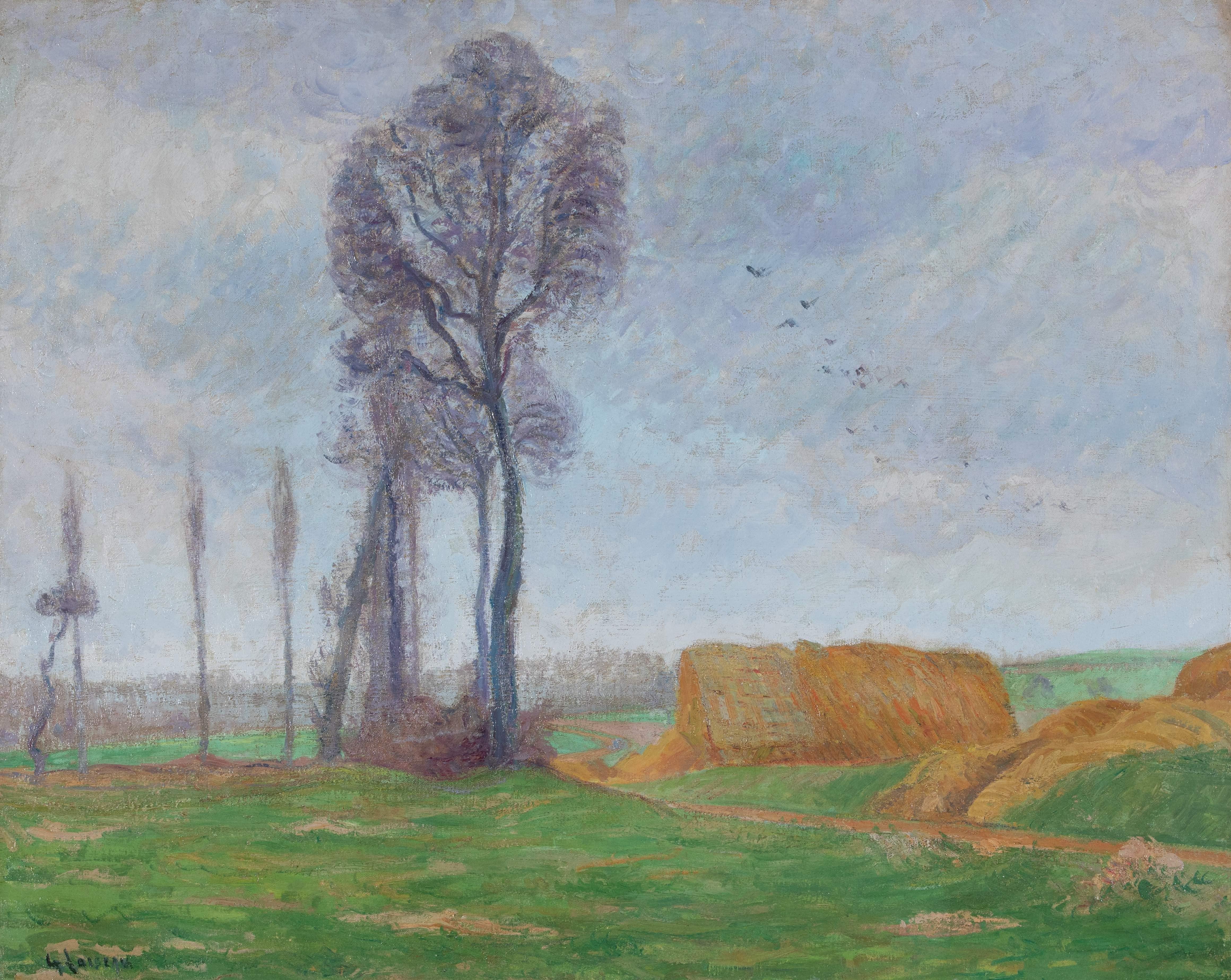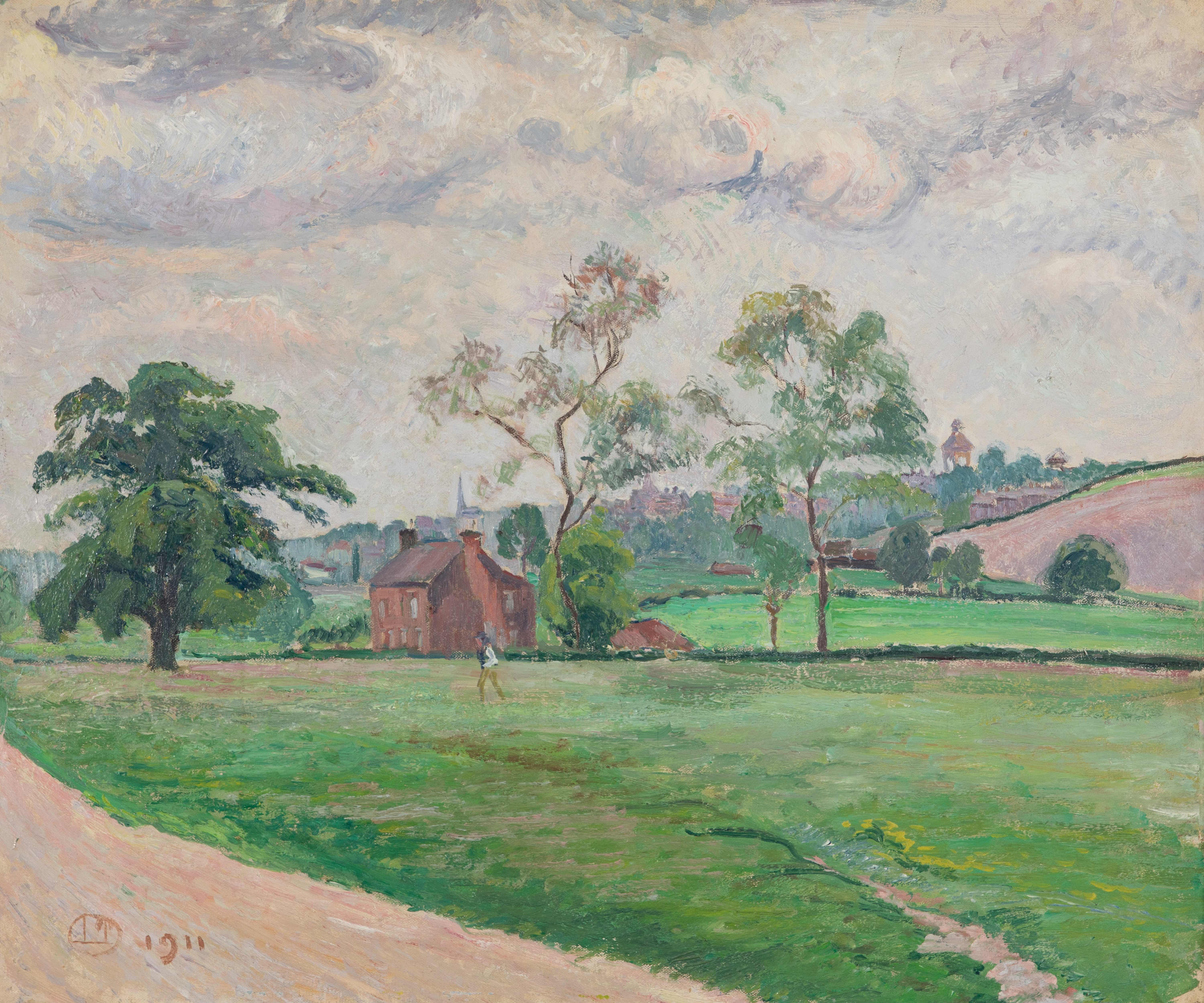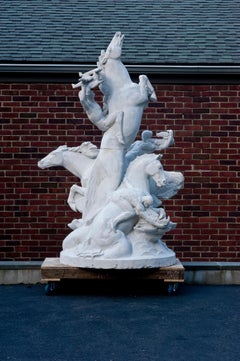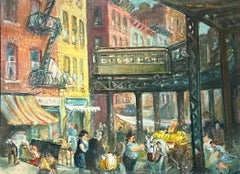
"Place de l'Opera, Paris, " Antoine Blanchard, French Impressionist Street Scene
View Similar Items
Antoine Blanchard"Place de l'Opera, Paris, " Antoine Blanchard, French Impressionist Street Scene
About the Item
- Creator:Antoine Blanchard (1910-1988, French)
- Dimensions:Height: 19.25 in (48.9 cm)Width: 24.25 in (61.6 cm)
- Medium:
- Movement & Style:
- Period:
- Condition:
- Gallery Location:New York, NY
- Reference Number:1stDibs: LU115626900822
Antoine Blanchard
Antoine Blanchard was born in France on November 15, 1910, in a small village near the banks of the Loire. He was the eldest of three children, and his father, a carver, managed a small carpentry and furniture shop. Blanchard would watch his father hand carve the furniture, and he began to display an artistic flair early in life — in an effort to promote this talent, his parents sent him to Blois for drawing lessons. He continued his training in Rennes at the Ecole des Beaux-Arts where he studied sculpture and drawing. Upon completion of his studies, he was awarded the school’s highest award: Le Prix du Ministre.
By 1932 Blanchard left Rennes and traveled to Paris to study. He enrolled at the Ecole des Beaux-Arts and after a few years entered the competition for the Prix de Rome. It was in Paris that he developed a love for the city and its street life. In 1939 Blanchard married a young woman he met in Paris, and in September of that year war broke out and he was called up for service. It was not until 1942 that he would return to his art.
Blanchard’s daughter Nicole was born in 1944 — she too would follow in the family tradition and after the birth of her two daughters, she became an artist working under the name A. Champeau. It was also around this time that Blanchard's father passed away, and he was compelled to return to his hometown and run the family business — giving him little time to paint.
The artist’s second daughter, Evelyn, was born in 1947, and by 1948, he had given control of the family business to his younger brother and returned to Paris to paint. Contemporary life in Paris had changed, and Blanchard longed for the bygone days. He began to research the Belle Époque period in Paris — reading and studying all the material on the period he could find.
Many of the subjects and scenes Blanchard portrayed were taken from images he collected of Paris during the 1890s, and he would often work on paintings for days or months before he finally felt they were complete. A.P. Larde comments in his book Antoine Blanchard, His Life His Work that he had always spent much time on his work — this explains why his production has always been rather limited, unlike the hurried and multiple proliferations of some modern artists. Delicate touches of luminous and shimmering tones produce a marvelous impression of harmony, brightness and light. Alternate shadings and lights, sensitive and mellow blending allow the artist to attain a hardly-ever reached degree of grace, of radiant and glimmering freshness.
Larde writes that Blanchard’s works are, first of all, a marvelous invitation to an ideal walk through old Paris, so different from that of today. Although a large number of historical monuments remain, today's Paris has little in common with Paris at the turn of the century; the scenery may be almost the same, but daily life as its characters has totally changed; the customs have been entirely transformed. In his landscape paintings, Blanchard invites us to relive this period by showing us pleasant strolls along embankments, squares and boulevards at a period in Parisian life when time did not count, when one had all one's time to idle, to stroll along the streets, to window-shop, to walk quietly along the boulevards or spend the afternoon in a sidewalk café.
Like his contemporary, Édouard Cortès, Blanchard devoted his artistic career to the depiction of Paris through all its daily and seasonal changes. But he was not an imitator of Cortès, but rather depicted the life of Paris at the turn of the century from his own point of view and with his own unique style. Blanchard always used small strokes, with a delicate, enveloping and mellow treatment; the slight haziness, which is a characteristic of his work, in many ways recalls the great masters of the Impressionist period.
Whether it was l'Arc de Triomphe, la Madeleine, Café de la Paix, Notre Dame or the dozens of other historical monuments and buildings of Paris, Blanchard’s focus was on the daily life of Paris at the turn of the century. His work became highly sought after, and collectors from around the world vied to acquire his new works. Today he is considered one of the leading exponents of the School of Paris painters.
Find original Antoine Blanchard paintings on 1stDibs.
(Biography provided by Lincoln Glenn)
- Till the Clouds Roll By 1945 Frank Sinatra Mid Century Modern Hollywood Film WPABy Richard WhorfLocated in New York, NYTill the Clouds Roll By 1945 Frank Sinatra Mid Century Modern Hollywood Film WPA TILL THE COULDS ROLL BY (Film Set), oil on canvas, 20 x 24 inches signed “Richard Whorf” lower right and signed and dated on the verso “R. Whorf/ Dec. 21, 1945. Frame by Hendenryk. ABOUT THE PAINTING This painting is from the collection of Barbara and Frank Sinatra, dated December 21, 1945 (just nine days after Frank Sinatra’s 30th birthday), and depicts the Metro-Goldwyn-Mayer Culver City backlot during the filming of Till the Clouds Roll By, the direction of the film having been taking over by Richard Whorf in December 1945. It is not presently clear if Whorf gave the Sinatras this painting as a gift, as the presence of the Dalzell Hatfield Galleries label on the verso indicates the painting may have been sourced there. Frank and Nancy Sinatra acquired a number of works from Dalzell Hatfield Galleries during the 1940’s, or perhaps they framed it for the couple. Sinatra performed “Old Man River’ in the film. Sinatra and June Allyson are depicted in the center of the painting. PROVENANCE From the Estate of Mrs. Nancy Sinatra; Dalzell Hatfield Galleries, Ambassador Hotel, Los Angeles. An image of the Dalzell Hatfield label and the back of the original frame (which we replaced with a stunning Heydenrk frame) are attached. Nancy Sinatra was Fran's first wife. Nancy Rose Barbato was 17 years old when she met Frank Sinatra, an 18-year-old singer from Hoboken, on the Jersey Shore in the summer of 1934. They married in 1939 at Our Lady of Sorrows Church in Jersey City where Frank gave Nancy a recording of a song dedicated to her titled "Our Love" as a wedding present. The young newlyweds lived and worked in New Jersey, where Frank worked as an unknown singing waiter and master of ceremonies at the Rustic Cabin while Nancy worked as a secretary at the American Type Founders. His musical career took off after singing with big band leaders Harry James and Tommy Dorsey...Category
1940s American Modern Landscape Paintings
MaterialsCanvas, Oil
- 1, 000 piece Museum Quality Collection of Art & Objects from NYC 1939 Worlds FairBy Chester BeachLocated in New York, NY1,000 piece Museum Quality Collection of Art & Objects from NYC 1939 Worlds Fair is available for sale. This sculpture, "Riders of the Elements," is the original 7' plaster maquette from the NYC 1939 World's Fair by Chester Beach...Category
1930s Art Deco Figurative Sculptures
MaterialsCanvas, Oil, Photographic Paper, Plaster
- NYC EL American Scene Social Realism Mid 20th Century Modern WPA Era FigurativeBy Cecil Crosley BellLocated in New York, NYNYC EL American Scene Social Realism Mid 20th Century Modern WPA Era Figurative Cecil Bell (1906 – 1970) Street Life Under the EL 22 x 30 inches Oil on canvas, c. 1930s Signed upper...Category
1930s American Realist Landscape Paintings
MaterialsCanvas, Oil
- NYC Cityscape American Scene WPA Modern Realism Mid 20th Century ArchitecturalBy Ernest FieneLocated in New York, NYNYC Cityscape American Scene WPA Modern Realism Mid 20th Century Architectural Ernest Fiene (1894-1965) Cityscape 36 x 30 inches Oil on canvas Signed and dated 1930. lower right Provenance Estate of the artist. ACA Galleries, New York Exhibited New York, Frank Rehn Gallery, Changing Old New York, 1931. New York, ACA Galleries, Ernest Fiene: Art of the City, 1925-1955, May 2-23, 1981, n.p., no. 5. BIO Ernest Fiene was born in Elberfeld, Germany in 1894. As a teenager, Fiene immigrated to the United States in 1912. He studied art at the National Academy of Design in New York City from 1914 to 1918, taking day classes with Thomas Maynard and evening classes with Leon Kroll. Fiene continued his studies at the Beaux-Arts Institute of Design in New York from 1916 to 1918, adding classes in printmaking at the Art Students League in 1923. Fiene began his career as an artist in 1919 with his first exhibition of watercolors at the MacDowell Club arranged by his mentor Robert Henri. In 1923 the Whitney Studio Club mounted a large exhibition of his works. The following year he had an exhibition at the New Gallery in New York, which completely sold out all fifty-two works, including paintings, watercolors, drawings, and etchings. With the proceeds of sales from the New Gallery exhibition, Ernest Fiene and his younger brother Paul, a sculptor, built studios in Woodstock, New York in 1925. In the early Twenties Ernest Fiene painted mostly landscapes of Woodstock and both the Ramapo and Hudson River Valleys. The first monograph from the Younger Artists Series was published on Fiene in 1922. Published in Woodstock, the series went on to include Alexander Brook, Peggy Bacon, and Yasuo Kuniyoshi. The book reproduced 1 illustration in color and another 27 reproductions in black and white. Around 1925 Fiene became fascinated with the intensity, excitement, and opportunities for color harmonies New York City offered as a subject. His paintings shifted to urban and industrial themes with architecture, industry, and transportation becoming his subjects. By 1926 Fiene had attracted the dealer Frank K.M. Rehn, who gave him a one-man exhibition that year, which travelled to the Boston Arts Club. C.W. Kraushaar Galleries gave Fiene a one-man exhibition of urban, landscape, portrait, and still life paintings in 1927. Julianna Force, the director of the Whitney Studio Club and first director of the Whitney Museum of American Art, included two of Fiene’s paintings in a fall exhibition in 1928. The Whitney Studio Club showed Fiene’s paintings in a two-man exhibition with Glenn O. Coleman that year and acquired three of Fiene’s paintings. Also in 1928 Fiene became affiliated with Edith Halpert’s Downtown Gallery where he had an exhibition of 20 lithographs in the spring. Fiene sold his house in Woodstock in 1928 to spend more of his time in New York City. With so many successful exhibitions, Fiene returned to Paris in 1928-29 where he rented Jules Pascin's studio and studied at the Académie de la Grande Chaumière. In France, Fiene painted both landscape and urban subjects developed from ideas influenced by Cubist geometry and the use of flat areas of broad color. Upon returning to New York in 1930, Fiene used this new approach to continue to paint New York skyscraper and waterfront subjects, as well as to begin a series of paintings on changing old New York based on the excavations for Radio City Music Hall and the construction of the Empire State Building. Frank K.M. Rehn Galleries exhibited this series, titled “Changing Old New York,” in 1931. Fiene also has solo exhibitions at Rehn Galleries in 1930 and 1932. Fiene’s oil paintings are exhibited at the Chicago Arts Club in 1930 as well. Fiene was included in the Museum of Modern Art’s exhibition Painting and Sculpture by Living Americans in December of 1931. Visiting New York, Henri Matisse saw the exhibition and called Fiene’s Razing Buildings, West 49th Street the finest painting he had seen in New York. Fiene had two mural studies from his Mechanical Progress series exhibited at the Museum of Modern Art’s exhibition Murals by American Painters and Photographers in 1932. Fiene sent View from my Window which depicts Fiene working on a lithograph stone while looking out his window to the newly completed Empire State Building to the Carnegie International in 1931. In 1932 Fiene participated in the first Biennial of American Painting at the Whitney Museum and his prints were included in exhibitions at the Downtown Gallery and the Wehye Gallery. In the same year, Fiene was awarded a Guggenheim fellowship to further study mural painting in Florence, Italy. On his return from Italy in 1933 Fiene re-engaged himself in New York City life and won several public and private mural projects. Fiene resumed his active exhibition schedule, participating in two group exhibitions at the Whitney Museum and a one-man exhibition of recent paintings at the Downtown Gallery in January 1934. In 1933 he purchased a farm in Southbury, Connecticut, which added Connecticut scenes to his landscape subjects. This was also the year Fiene began to spend summers on Monhegan Island, Maine, where he painted seascapes, harbor scenes, and still lifes. Fiene’s landscape paintings attracted numerous commissions as part of the American Scene movement. Through the fall and winter of 1935-36, Fiene took an extended sketching trip through the urban, industrial, and farming areas of Pennsylvania and West Virginia. Most of the twenty-four Pennsylvania urban and rural paintings...Category
1930s American Modern Landscape Paintings
MaterialsCanvas, Oil
- NYC 1939 World's Fair Mural Study American Scene WPA Modern Mid 20th CenturyLocated in New York, NYNYC 1939 World's Fair Mural Study American Scene WPA Modern Mid 20th Century Eugene Savage (1883 – 1978) 1939 World’s Fair Mural Study 45 x 30 inches Oil on Canvas Signed lower right The painting is part of a 1,000 piece collection of art and objects from the 1939 World’s Fair. The collection as a whole is available. Savage created the mural for the facade of the Communications Building. An image of the completed mural, along with a published postcard, is part of the listing. Note the center top female figure, she resembles the figure in the offered painting. BIO Eugene Francis Savage was born in Covington, Indiana 1883. He underwent various forms of art training in the early years. He was a pupil of The Corcoran Gallery and The Art Institute of Chicago, and was later awarded a fellowship to study in Rome at The American Academy. While under the spell of that ancient city the young artist began to render historic figures that were suitable for the classic style needed for mural painting in the traditional manor. During this period he was able to study and observe Roman and Greek sculpture, although much of the academic training was accomplished by using plaster casts along with the incorporation of live models. This method survived and was used efficiently throughout Europe and the United States. After leaving the Academy, Savage was commissioned to paint numerous murals throughout the United States and Europe. This artist received acclaim for the works he produced while under commissions from various sources. This young master was a contemporary of Mexican muralists David Alfaro Siqueiros (1896-1974), Jose Clemente Orozco (1883-1949) and Diego Rivera (1886-1957). In this period he was to show the influence of his contemporaries in formulating a modern style. Savage also played a vital role in the WPA Federal Art program, and he was a member of The Mural Art Guild.. Savage was elected an associate member of The National Academy of Design in 1924 and a full member in 1926. From 1947, he held a professorship at Yale University where he taught mural painting, and some of his students went on to significant positions. By this time the artist had painted large-scale murals at Columbia, Yale University, Buffalo N.Y., Dallas, Texas, Chicago, Indiana, along with other commissioned works. He also achieved recognition for a series of murals commissioned by the Matson Shipping Line and completed around 1940. For this commission, Savage made many exacting studies of customs and folkways of the Hawaiian natives. However, the award-winning murals were not installed as planned but were put in storage during the war years when the ships were used for troop transportation and were in danger of attack. However the mural images were reproduced and distributed by the shipping company including nine of the mural scenes that were made into lithographed menu covers in 1948. The American Institute of Graphic Arts awarded certificates of excellence for their graphic production, and the Smithsonian Institute exhibited the works in 1949. Today Savages' Hawaiian Art production is held in high regard by collectors of Hawaiian nostalgia. In later years the artist focused his attention on a theme that dealt with the customs and tribal traditions of the Seminole Indians of Florida. He produced many variations of this theme throughout his lifetime, and the pictures were usually modest scale easel paintings, precise and carefully delineated. Many of these pictures incorporate Surrealistic elements and show some minor stylistic influences of the painters Kay Sage...Category
1930s American Modern Figurative Paintings
MaterialsCanvas, Oil
- Boys Swimming Industrial Landscape WPA Mid 20th Century Social Realism ModernismBy Henry Ernst SchnakenbergLocated in New York, NYBoys Swimming Industrial Landscape WPA Mid 20th Century Social Realism Modernism Henry Schnakenberg (1982 - 1970) Boys Swimming Industrial Landscape 11 1/2 x 15 1/2 sight Oil on Canvas Signed lower left 14 1/2 x 18 1/2 inches, Framed Bio In many cases, American artists visited the Armory Show in New York in 1913, and returned to their studios to react to or against what they saw. However, for Henry Ernest Schnakenberg it was much more life altering. Prior to visiting this important exhibition of American and European modernist art...Category
1940s American Modern Figurative Paintings
MaterialsOil, Canvas
- Ireland Seascape Landscape with Boats & Figures by Contemporary Irish ArtistLocated in Preston, GBIreland Lake Seascape Landscape with Boats & Figures by Contemporary Irish Artist, Frank Fitzsimons Art measures 20 x 16 inches Frame measure 27 x 2...Category
1980s Post-Impressionist Landscape Paintings
MaterialsCanvas, Oil
- Blue Seas Of The South Coast Brittany French Post Impressionist Signed OilLocated in Cirencester, GloucestershireBrittany by Josine Vignon (French 1922-2022) signed on front and back oil painting on canvas, unframed canvas: 15 x 18 inches Colors: Blue colors, beige, brown, green and white Ve...Category
Mid-20th Century Post-Impressionist Landscape Paintings
MaterialsOil, Canvas
- Gondolas, Venetian Canal By Jane PetersonBy Jane PetersonLocated in New Orleans, LAJane Peterson 1876–1965 American Gondolas, Venetian Canal Signed “Jane Peterson” (lower right) Oil on canvas This remarkable painting, Gondolas, Venetian Canal, by the esteemed A...Category
20th Century Post-Impressionist Landscape Paintings
MaterialsCanvas, Oil
- The Garden Near Cailhau By Achille LaugéBy Achille LaugéLocated in New Orleans, LAAchille Laugé 1861-1944 French The Garden Near Cailhau Signed "A. Laugé 96" (lower left) Oil on canvas “Laugé’s art is one of great sensitivity and controlled reason; he is a mas...Category
19th Century Post-Impressionist Landscape Paintings
MaterialsCanvas, Oil
- La Terrasse Devant La Mer By Jean Pierre CassigneulLocated in New Orleans, LAJean-Pierre Cassigneul b.1935 French La terrasse devant la mer (The Terrace by the Sea) Signed “Cassigneul” (lower left) Oil on canvas laid on panel This monumental, three-panele...Category
20th Century Post-Impressionist Figurative Paintings
MaterialsCanvas, Oil, Panel
- Boulevard De Clichy - Post Impressionist City Landscape Painting by Albert AndreBy Albert AndreLocated in Marlow, BuckinghamshireSigned and titled figures in cityscape oil on canvas circa 1920 by post impressionist painter Albert Andre. This stunning and good-sized work depicts a view of the Boulevard de Clichy, a famous street in the city of Paris, France on what appears to be a sunny but cool day. Signature: Signed lower left and titled & dated on original label verso Dimensions: Framed: 29"x35" Unframed: 22"x28" Provenance: New York, Durand-Ruel, Exhibition of Paintings by Albert André, 1 February -18 February, 1921 He came to Paris in 1889 as an industrial designer. At the age of 23 he enrolled at the studio of William Bouguereau at the Académie Julian, where he met Ranson, Louis Valtat and the young poet and dramatist Henry Bataille, who at the time was training as a painter. He illustrated L'étang de Berre by Charles Maurras and Les Petites Alliées by Claude Farrère. He produced cartoons for tapestries...Category
1920s Post-Impressionist Landscape Paintings
MaterialsCanvas, Oil
